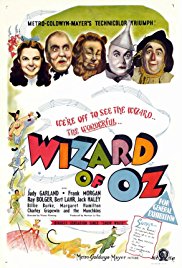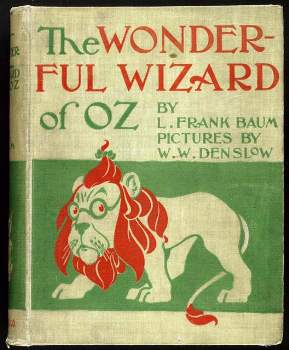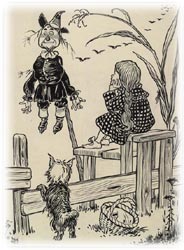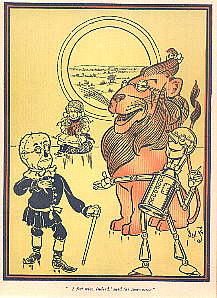UNDERSTANDING THE STORY
Almost all children will need help in answering these questions. Ask these questions after children watch the movie and then let them watch the movie again.
1. Did you recognize someone in Oz who reminded you of Miss Gulch? Who was she? Was there someone in Oz who was like Professor Marvel, the man who told Dorothy’s fortune with the crystal ball? Who was he? Were there people in Oz who were like the farmhands? Who were they?
Suggested Responses:
The dream transformed Miss Gulch to the Wicked Witch of the West; the three farmhands to the Scarecrow, the Cowardly Lion and the Tin Man, and Professor Marvel into the Wizard of Oz.
2. Despite the courage of the Cowardly Lion, the intelligence of the Scarecrow, the compassion of the Tin Man, and the wisdom of the Wizard, Dorothy is the real hero of this story. Compare Dorothy’s story to the story of another hero that you know and tell us some of the ways in which their stories are alike.
Suggested Response:
You can pick any story. What about Luke Skywalker of the first Star Wars movie? Both Dorothy and Luke are separated from their home and must undertake a journey. Her journey is to return home and Luke’s journey is to find his father (although he doesn’t know it at the time). They both find helpful and protective figures. Skywalker meets Obi-Wan Kenobi. Dorothy meets Glinda, her three friends, and later the Wizard. They both go through many ordeals and eventually gain their reward. Both Dorothy and Luke triumph because of the inner force of their characters which they carried with them from the beginning. Luke had “the Force” which ran strong and deep within him. Dorothy had her strength of character (symbolized by the ruby slippers). However, before either of them could complete their journey these inner strengths had to be developed and tested.
3. How does Dorothy change through the course of the story told by this movie?
Suggested Response:
There is no one right answer. A good answer would include that she came to know her own strength and resourcefulness or that she grew in self-confidence.
4. Did Oz really happen or was it just Dorothy’s dream?
Suggested Response:
Most people say that in the movie, Oz was just Dorothy’s dream populated by characters from Dorothy’s life changed by her imagination. But then, at the end of the film Uncle Henry says that they do believe her. Was he just humoring her or was he being serious? In short, there are two sides to this argument.
5. In our dreams, our minds work out our wishes and our fears, especially in relation to what happened during the day before. Name two fears and one wish that Dorothy was working out in her dream about Oz. When thinking about Dorothy’s wishes, remember that people’s wishes often conflict so it is possible that Dorothy could want two different and opposite things.
Suggested Response:
See Helpful Background Section for a list of fears. Some of Dorothy’s wishes were: to get rid of Miss Gulch (the Wicked Witch) so that she couldn’t hurt Toto anymore; to experience the exciting life beyond the grayness of Kansas; to stay home with her aunt and uncle; to save Toto; for Auntie Em to be more like Glinda.
6. Why is the land of Oz green?
Suggested Response:
It is the land of hope. The color green is often associated with hope. (If the film is being used to study history, there is an additional analogy. Oz is the city of Washington, D.C., where money often holds sway according to the populist analogy theory.)
7. A symbol is something in a story that stands for something else. What does the tornado stand for?
Suggested Response:
There are at least two possibilities. The tornado is a symbol of the strong emotions felt by Dorothy when Auntie Em and Uncle Henry could not stop Miss Gulch from taking Toto. The tornado can also be interpreted as a symbol of the chance events that can happen in life that change our lives forever. It is really more an example of that than a symbol.
QUESTIONS RELATING TO THE HOPES AND FEARS OF CHILDREN AGES 5 – 12
Often the issues raised by this film are too disturbing to be discussed directly which, of course, is why we have fairy tales. Therefore, TWM suggests that teachers and parents ask questions which do not directly refer to how children feel about the issues described below. Have the children put themselves “in the ruby slippers”, i.e., how would they feel if they were in Dorothy’s shoes or how do they think Dorothy felt. Questions can also focus on how Dorothy successfully resolved these issues. Parents or teachers who are good storytellers can make up a story with some of the same thematic elements. Young children delight in stories about the characters they saw in a movie.
Make sure that each of the questions below is appropriate for the developmental level of your child or class.
CONCEPT:
Home is the center of a child’s life. But children know that somewhere beyond the safety of home there is a world that is exciting and colorful, yet uncertain and in some ways, dangerous. This both attracts and frightens them. What if the home is destroyed or the child is suddenly taken away from home before he or she has had a chance to grow up? Will the child survive? Will he or she ever be able to find the way back?
8. At the beginning of the movie, Dorothy was singing about wanting to be “Somewhere Over the Rainbow”. By the end of the movie she realized that “There’s no place like home”. What happened to change her mind?
Suggested Response:
Before the tornado, Dorothy didn’t realize that going away from home meant leaving the people she loved. When she landed in Oz, Dorothy realized that she was alone and suddenly Kansas didn’t seem so bad. In fact, all she wanted to do while she was in Oz was to get back home. A parent or teacher can also comment that this often happens to people; that they want something very badly but they don’t think about the consequences of getting what they want.
9. How do you think Dorothy felt when she woke up from the tornado and found that the farm and Auntie Em and Uncle Henry were gone and that everything was different?
Suggested Response:
If the child is reluctant to answer the adult can volunteer “Well, I would have been terrified and excited at the same time. Where was my home? Where were my relatives? But Oz was so beautiful and exciting.” This is the indirect approach. You can follow it up with — “How would you have felt if you had been there instead of Dorothy?” or the reassuring question: “How do you think Dorothy felt when she got home?”
10. Do you know any children who have had to leave their homes in real life? What happened to them? Comment: If a child knows of a situation like this, the question will permit them to express their feelings about it. Whatever the child’s answer the adult should stress the fact that this situation is very unusual and provide reassurance that it is not something the child needs to worry about.
CONCEPT:
What about relationships with grownups? Mothers and fathers are all-powerful to a young child but a child soon learns that this power has limits, as when Auntie Em and Uncle Henry couldn’t prevent Miss Gulch from taking Toto.
11. Just before the storm, why didn’t Auntie Em and Uncle Henry stop Miss Gulch from taking Toto? How do you think Dorothy felt about this? Comment: The answer to the first question is that there was an order from the sheriff. An answer to the second question allows a child to talk about his or her fears triggered by this incident. These are very strong emotions. The tornado is a symbol of the strength of Dorothy’s emotions. There are a number of words to describe what Dorothy’s feelings could have been. They include frustration, betrayal, and hurt. Dorothy may have felt that her world was changing in ways she didn’t like, since before this she had thought Uncle Henry and Auntie Em to be all-powerful. But it does happen sometimes that parents cannot protect their children.
CONCEPT:
How does a child learn what he or she needs to know to get through tough situations?
The following three questions should be asked in a group.
12. How did Dorothy make it through all those dangerous situations in Oz?
Suggested Response:
There is no one correct answer. Good answers will contain some of the following concepts: She took things one at a time. She was respectful and kind to people and tried to help them. She chose her friends well. She met each challenge with courage and determination. She never lost sight of her goal.
13. What does this movie tell us about the solutions to some of our own problems?
Suggested Response:
This movie tells us that many times solutions to our problems lie within ourselves. All the time that Dorothy was in Oz searching for a way home, the solution (the ruby slippers) were right there on her feet. She just didn’t know how to make them work. The filmmakers were trying to tell us that the key to our heart’s desire is often within ourselves, we just have to discover how to unlock our own potential.
14. Did Dorothy change as a result of her experiences in Oz?
Suggested Response:
Yes. The experiences in Oz forced Dorothy to call upon her own strengths. She learned that she could fight for herself and overcome obstacles and evil forces.
15. Why couldn’t Dorothy use the ruby slippers to get home at the beginning of the film, right after they appeared on her feet?
Suggested Response:
Dorothy needed to be ready. She needed the growth and the knowledge of her own strength and power that came from the experiences that she had in Oz.
CONCEPT:
Can children ever triumph over evil adults?
16. What would you have done to the Wicked Witches that Dorothy met in Oz?
Suggested Response:
It is possible for children to triumph over evil adults but sometimes it is hard. Adults should point out that Dorothy is a very strong and resourceful girl. She meets every challenge with determination and intelligence. Eventually, she triumphs.
17. Is there anyone that you know who seems be like Miss Gulch? Comment: The purpose of this question is to allow children to talk about their own fears. If a child says that he or she doesn’t know anyone like that, then the child should be reassured. If the child does name someone, an adult asking this question must decide what to do about it. Either to reassure the child, to take some action to reconcile the child with the person, or to take some action to protect the child from the person.
CONCEPT:
What about misleading appearances? How do you tell appearance from reality?
18. Are things always what they seem?
Suggested Response:
The obvious answer is that they aren’t. Children should be reassured that as they get older it will get easier to tell what is real and what is not. However, it should be acknowledged that everyone, no matter what their age, must deal with this question. As people get older and wiser, it gets easier to separate appearance from reality, but adults still have to work at it. Sometimes its hard to tell and you have to look very carefully. Sometimes most everyone is fooled, like in the Emerald City.
19. How do you determine which appearances to trust and which not to trust?
Suggested Response:
You use common sense and all of the information that is available. You keep your eyes and ears open. That’s why being older helps, because you’ve had more experiences and more chances to see how the world really works.
20. What appearances in this movie are misleading?
Suggested Response:
There are many: the power of the Wizard of Oz; the ability of Professor Marvel to see into the future; the idea that Dorothy is a powerless little girl; the Scarecrow’s stupidity; the Tin Man’s lack of heart; and the Lion’s cowardice.
CONCEPT:
What is the nature of power? How do people get other people to do what they want? (This is a very complex question but it isn’t bad for kids to start thinking about it.)
21. How did the Wizard come to power in the city of Oz and become renowned as a great and powerful wizard?
Suggested Response:
The people of Oz wanted to believe that he was a great and powerful man. It is people’s agreement that allows others to hold power.
CONCEPT:
How can a child ever meet the challenge of learning what a person needs to know to be an adult (the Scarecrow)?
22. How does a child learn what he or she needs to be an adult?
Suggested Response:
There is no one right answer. A good response will include going to school, learning a trade, becoming mature, listening to their parents, and watching how others behave. The adult asking this question should assure the child that there are many ways to get this knowledge and that he or she will succeed.
CONCEPT:
How can a child ever learn to have courage even when he or she is very scared?
23. Do courageous people feel fear?
Suggested Response:
Yes, absolutely.
24. How does a person who is afraid act with courage?
Suggested Response:
Courageous people know what they must do and they do it, even though they may be very much afraid. If a child is interested in this question, it might be a good idea to read to them or have them read The Red Badge of Courage. See Learning Guide to “The Red Badge of Courage“.
OTHER DISCUSSION QUESTIONS
25. See Discussion Questions for Use With any Film that is a Work of Fiction.
26. Why was Dorothy so happy to return home to a drab existence in Kansas when the land of Oz was so beautiful and colorful?
Suggested Response:
Kansas was home and the people that she loved were there.
27. Some people contend that the story is driven by the inadequacy of adults and shows that Dorothy must make her own way. Analyze the story from this perspective and give some examples of the inadequacy of adults that had to be overcome by Dorothy.
Suggested Response:
When Dorothy runs away the first time, she is trying to protect Toto from Miss Gultch. Auntie Em and Uncle Henry had been powerless to stop Miss Gulch from taking Toto. The Wizard could not stop the Wicked Witch of the West nor could he control the balloon.





